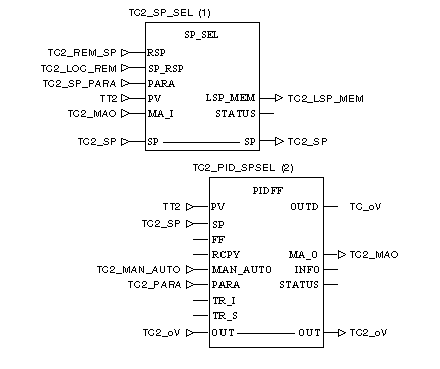|
Detailed description
|
|
|
Original instructions
|
|
If
|
Then
|
|---|---|
|
the local setpoint is switched to a remote setpoint
|
|
|
the remote setpoint is switched to a local setpoint
|
|
If
|
Then
|
|---|---|
|
bump = 0
|
the changeover is bumpless: The function block stops copying the RSP input to the SP output. The local setpoint value SP then corresponds to the last remote setpoint value RSP that was present before the changeover. The user can then modify this. In this case it is not necessary to attach the LSP_MEM output.
|
|
bump = 1
|
the value of the LSP_MEM output is moved to the SP output during changeover (bumps can occur here). The value given for LSP_MEM corresponds to the last setpoint value SP before the function block transfers to remote mode. To restart the local mode with a different setpoint, it is sufficient to modify LSP_MEM as long as the block remains in remote mode (for further details see "Function of the output LSP_MEM").
|
|
Type of setpoint
|
Behavior of the output
|
|---|---|
|
Local setpoint
|
The value of SP is continuously moved to LSP_MEM.
|
|
Changeover to remote setpoints
|
The value of LSP_MEM is no longer modified by the function block and therefore retains the value of the last local setpoint used.
|
|
Reverting to the local setpoint
|
There are three possibilities for this:
|

TC2_SPis entered by the operator in "local setpoint" operating mode.